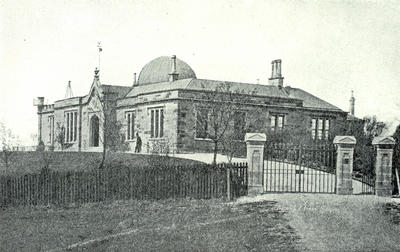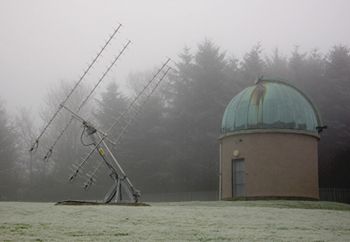Observatory marks 250th anniversary
Published: 31 August 2007
The University of Glasgow's Observatory has been looking to the heavens for 250 years.
It is not know exactly when the study of stars entered the curriculum at the University of Glasgow but by the 1690s astronomy was being studied by students in their final year. Practical sessions involved the use of the two telescopes owned by the University.
On 17 August 1757, two hundred and fifty years ago, the foundation stone of the first purpose built observatory in Glasgow was laid on Dowhill, in the south-east grounds of the University, then in the centre of the town. It was named the Macfarlane Observatory, as it was built to house a very fine collection of astronomical instruments bequeathed to the University by Alexander Macfarlane, a merchant in Jamaica.
Macfarlane had been educated at the University, graduating with a MA in 1728, and would have attended the astronomy lectures of Robert Dick, Professor of Natural Philosophy. He emigrated to Kingston, Jamaica, prior to November 1735 and became the island’s first postmaster-general.

In 1747 Macfarlane bought the astronomical collection of Colin Campbell, a fellow Glasgow University alumnus domiciled on the island, and set about building a house that could also be his observatory. The instruments themselves have been described as being worthy of those in use at that time in the Royal Observatory at Greenwich in London. Within a year of Macfarlane’s death in August 1755, these mainly iron instruments had been packed up and sent to Glasgow but on their arrival it was discovered that the salt air during the voyage had caused damage.
The man asked to repair the Macfarlane instruments was James Watt, the famous inventor and engineer, who had just returned to Glasgow from London as a trained instrument maker. He was asked “to clean them and to put them in the best order for preserving them from being spoilt”.
In addition to being paid £5 sterling for his work he was also offered rooms in the University to carry out his work. This allowed him to set up in business in Glasgow, which had previously been denied to him, as he was not a burgess and not entitled to trade within the city boundaries. He was also able to use the title ‘mathematical-instrument-maker to the University’.

These encouragements initiated his great innovations, inventions and engineering insights for which he still has a worldwide reputation.
Both the original inventory of the astronomical instruments – in French, the native language of the Swiss-Jamaican compiler, Pierre Martel – and James Watt’s account for his work done on repairing them holds pride of place in the University’s Archives. While in the Hunterian Museum one of the Macfarlane telescopes, made by James Short, is still in existence.
Important research was carried out at the Dowhill Observatory. Alexander Wilson, the first professor of Practical Astronomy, appointed by King George II in 1760, was awarded the Gold Medal of the Royal Society of Sciences in Copenhagen in 1772 for his pioneering work on sunspots. His discovery of the Wilson Effect started research in solar physics that continues to be a major research interest within the University today.
By the 1830s, the usefulness of the Dowhill Observatory had come to an end due to the high levels of pollution caused by the rapid industrialisation and growth of Glasgow. Its citizens, many of whom had been inspired by the public lecture courses given by John Pringle Nichol, the fourth Chairholder of Astronomy, formed a group known as "The Friends of Astronomical Science in Glasgow".
They established a new Observatory on Horselethill in the West End, then many miles from the University in the City. A legacy of its location is Observatory Road, running off Byres Road. The University took the building over and John Nichol moved there in 1841 continuing to purchase new equipment and expand the facilities.
One of the stained glass windows in the University’s Bute Hall commemorates his life and work as an inspirational teacher and researcher. The Horselethill Observatory continued to contribute to astronomical research and understanding. A catalogue of 6,415 stars observed between 1860 and 1881 was followed by another catalogue of 2,156 stars in 1892. Many public clocks in the city were controlled by the Observatory’s time-keeping service. Ludwig Becker, professor of Astronomy from 1893 to 1937, undertook a series of ground-breaking research in the new technique of spectroscopy and completed a long series of observations of 200 nebulae.
Horselethill Observatory also fell foul of the continuing growth of Glasgow and its pollution and became inoperable as a place for observing the stars. Becker’s successor in 1937, Professor William Smart, a renowned researcher of trends in stellar movements, oversaw the building of a new instructional observatory in University Gardens (on the site now occupied by the QM Union). By the 1950s this observatory was replaced by another situated in the University’s Garscube Estate, and in the late 1980s the research telescopes were moved to the University’s Cochno Estate in the Kilpatrick Hills, although observational telescopes remain, and are very active at, Acre Road.
The study of the stars in 2007 is continued by the Astronomy and Astrophysics Group http://www.astro.gla.ac.uk/ within the Department of Physics & Astronomy. The group conducts research and teaching in a wide range of topics, including solar, stellar and plasma physics, cosmology, polarimetry and radio astronomy, continuing the work of Alexander Wilson and the other pioneering astronomers of the University of Glasgow.
It is fitting that on the 250th anniversary of the laying of the foundation stone of the first Glasgow observatory astronomers from all over the UK are heading to Glasgow for the British Astronomical Association ‘Out of London’ Meeting which kicks off on August 31.
http://www.astronomicalsocietyofglasgow.org.uk/
http://www.universitystory.gla.ac.uk/
First published: 31 August 2007
<< September

